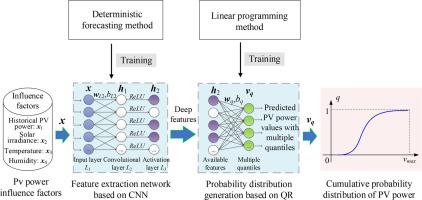当前位置:
X-MOL 学术
›
Energy Convers. Manag.
›
论文详情
Our official English website, www.x-mol.net, welcomes your feedback! (Note: you will need to create a separate account there.)
Improved quantile convolutional neural network with two-stage training for daily-ahead probabilistic forecasting of photovoltaic power
Energy Conversion and Management ( IF 10.4 ) Pub Date : 2020-09-01 , DOI: 10.1016/j.enconman.2020.113085 Qian Huang , Shanyang Wei
Energy Conversion and Management ( IF 10.4 ) Pub Date : 2020-09-01 , DOI: 10.1016/j.enconman.2020.113085 Qian Huang , Shanyang Wei

|
Abstract Probabilistic forecasting is significant in coping with the strong uncertainty of photovoltaic (PV) power, which provides the occurrence scope and corresponding probability information of PV power for the decision of power systems. Convolutional neural networks (CNNs), one of the most advanced and widely used deep-learning methods, are regarded as a promising method for predicting PV power. This paper proposes a daily-ahead probabilistic PV power forecasting method based on an improved quantile CNN (QCNN). First, the QCNN constructs a feature extraction network based on CNNs to mine the deep features of the PV power influence factors. Thereafter, quantile regression (QR) is employed to generate the PV power probability distribution based on the extracted features. However, QR produces non-differentiable loss functions that significantly hinder the training of QCNNs. To address this problem, a two-stage training strategy is proposed in which a CNN is trained using a deterministic forecasting method, and QR is trained using a linear-programming method. This strategy ensures that the training of QCNNs can avoid the effects of the non-differentiable loss functions such that the QCNN can play a complete role in the prediction. The case of a PV plant in Australia demonstrates that QCNNs produce a considerably superior effect when compared to the quantile extreme learning machine, quantile echo state network, direct QR, and radial basis function neural network. The proposed method can be beneficial in terms of decision-making in power systems.
中文翻译:

具有两阶段训练的改进分位数卷积神经网络,用于光伏发电的每日超前概率预测
摘要 概率预测对于应对光伏发电的强不确定性具有重要意义,它为电力系统决策提供了光伏发电的发生范围和相应的概率信息。卷积神经网络 (CNN) 是最先进和使用最广泛的深度学习方法之一,被认为是一种很有前途的光伏功率预测方法。本文提出了一种基于改进分位数CNN(QCNN)的每日超前概率光伏功率预测方法。首先,QCNN基于CNNs构建特征提取网络,挖掘光伏功率影响因素的深层特征。此后,采用分位数回归 (QR) 根据提取的特征生成 PV 功率概率分布。然而,QR 产生不可微的损失函数,严重阻碍了 QCNN 的训练。为了解决这个问题,提出了一种两阶段训练策略,其中使用确定性预测方法训练 CNN,使用线性规划方法训练 QR。这种策略确保 QCNN 的训练可以避免不可微损失函数的影响,从而使 QCNN 可以在预测中发挥完整的作用。澳大利亚光伏电站的案例表明,与分位数极限学习机、分位数回波状态网络、直接 QR 和径向基函数神经网络相比,QCNN 产生了相当优越的效果。所提出的方法在电力系统的决策方面可能是有益的。提出了一种两阶段训练策略,其中使用确定性预测方法训练 CNN,使用线性规划方法训练 QR。这种策略确保 QCNN 的训练可以避免不可微损失函数的影响,从而使 QCNN 可以在预测中发挥完整的作用。澳大利亚光伏电站的案例表明,与分位数极限学习机、分位数回波状态网络、直接 QR 和径向基函数神经网络相比,QCNN 产生了相当优越的效果。所提出的方法在电力系统的决策方面可能是有益的。提出了一种两阶段训练策略,其中使用确定性预测方法训练 CNN,使用线性规划方法训练 QR。这种策略确保 QCNN 的训练可以避免不可微损失函数的影响,从而使 QCNN 可以在预测中发挥完整的作用。澳大利亚光伏电站的案例表明,与分位数极限学习机、分位数回波状态网络、直接 QR 和径向基函数神经网络相比,QCNN 产生了相当优越的效果。所提出的方法在电力系统的决策方面可能是有益的。这种策略确保 QCNN 的训练可以避免不可微损失函数的影响,从而使 QCNN 可以在预测中发挥完整的作用。澳大利亚光伏电站的案例表明,与分位数极限学习机、分位数回波状态网络、直接 QR 和径向基函数神经网络相比,QCNN 产生了相当优越的效果。所提出的方法在电力系统的决策方面可能是有益的。这种策略确保 QCNN 的训练可以避免不可微损失函数的影响,从而使 QCNN 可以在预测中发挥完整的作用。澳大利亚光伏电站的案例表明,与分位数极限学习机、分位数回波状态网络、直接 QR 和径向基函数神经网络相比,QCNN 产生了相当优越的效果。所提出的方法在电力系统的决策方面可能是有益的。
更新日期:2020-09-01
中文翻译:

具有两阶段训练的改进分位数卷积神经网络,用于光伏发电的每日超前概率预测
摘要 概率预测对于应对光伏发电的强不确定性具有重要意义,它为电力系统决策提供了光伏发电的发生范围和相应的概率信息。卷积神经网络 (CNN) 是最先进和使用最广泛的深度学习方法之一,被认为是一种很有前途的光伏功率预测方法。本文提出了一种基于改进分位数CNN(QCNN)的每日超前概率光伏功率预测方法。首先,QCNN基于CNNs构建特征提取网络,挖掘光伏功率影响因素的深层特征。此后,采用分位数回归 (QR) 根据提取的特征生成 PV 功率概率分布。然而,QR 产生不可微的损失函数,严重阻碍了 QCNN 的训练。为了解决这个问题,提出了一种两阶段训练策略,其中使用确定性预测方法训练 CNN,使用线性规划方法训练 QR。这种策略确保 QCNN 的训练可以避免不可微损失函数的影响,从而使 QCNN 可以在预测中发挥完整的作用。澳大利亚光伏电站的案例表明,与分位数极限学习机、分位数回波状态网络、直接 QR 和径向基函数神经网络相比,QCNN 产生了相当优越的效果。所提出的方法在电力系统的决策方面可能是有益的。提出了一种两阶段训练策略,其中使用确定性预测方法训练 CNN,使用线性规划方法训练 QR。这种策略确保 QCNN 的训练可以避免不可微损失函数的影响,从而使 QCNN 可以在预测中发挥完整的作用。澳大利亚光伏电站的案例表明,与分位数极限学习机、分位数回波状态网络、直接 QR 和径向基函数神经网络相比,QCNN 产生了相当优越的效果。所提出的方法在电力系统的决策方面可能是有益的。提出了一种两阶段训练策略,其中使用确定性预测方法训练 CNN,使用线性规划方法训练 QR。这种策略确保 QCNN 的训练可以避免不可微损失函数的影响,从而使 QCNN 可以在预测中发挥完整的作用。澳大利亚光伏电站的案例表明,与分位数极限学习机、分位数回波状态网络、直接 QR 和径向基函数神经网络相比,QCNN 产生了相当优越的效果。所提出的方法在电力系统的决策方面可能是有益的。这种策略确保 QCNN 的训练可以避免不可微损失函数的影响,从而使 QCNN 可以在预测中发挥完整的作用。澳大利亚光伏电站的案例表明,与分位数极限学习机、分位数回波状态网络、直接 QR 和径向基函数神经网络相比,QCNN 产生了相当优越的效果。所提出的方法在电力系统的决策方面可能是有益的。这种策略确保 QCNN 的训练可以避免不可微损失函数的影响,从而使 QCNN 可以在预测中发挥完整的作用。澳大利亚光伏电站的案例表明,与分位数极限学习机、分位数回波状态网络、直接 QR 和径向基函数神经网络相比,QCNN 产生了相当优越的效果。所提出的方法在电力系统的决策方面可能是有益的。

























 京公网安备 11010802027423号
京公网安备 11010802027423号